Public perceptions of organised crime in Scotland: report
Findings from a module of questions on organised crime, included in the winter 2017 wave of the Ipsos MORI Scottish Public Opinion Monitor.
2. Awareness of organised crime
Illegal activities associated with organised crime
To gauge awareness of the nature of organised crime in Scotland, respondents were first asked what types of illegal activity they associated with the term. The most common response by some way was drug dealing or trafficking, mentioned by 68%. The next most common, mentioned by around a third as many respondents, were people or human trafficking for sexual or labour exploitation (22%) and money laundering (21%). Around one in ten respondents (9%) were unable to name any activity associated with organised crime.
As Figure 2.1 shows, these results were broadly consistent with those recorded in 2013, when the questions were last asked.
Figure 2.1: Types of illegal activity associated with
organised crime (most common answers given)
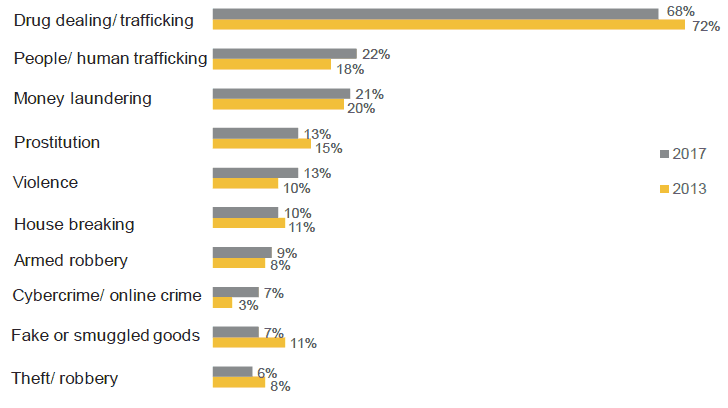
Base: All (1,088 in 2017 and 1,001 in 2013)
People living in the most deprived areas of Scotland were less likely than those in the least deprived to cite the top two responses – drug dealing or trafficking (69% compared to 75% of those in the least deprived areas) and people trafficking (16% compared to 33%).
Perceived seriousness and impact of organised crime
Asked how serious they thought organised crime was in their respective neighbourhoods, 30% of respondents said it was very or fairly serious, while 67% said it was not very or not at all serious ( Figure 2.2). These results were in line with those recorded in 2013.
More women than men regarded organised crime as a serious problem in their neighbourhoods (34% compared to 27% respectively), and many more people living in the most deprived areas did so than in the least deprived (57% compared to 15%).
There was more pronounced variation still depending on whether or not respondents had been personally affected by organised crime: almost two thirds (62%) of those who had, said organised crime was a serious problem in their neighbourhood, compared to 27% of those who had not been personally affected.
Figure 2.2: Perceived seriousness of organised crime in
neighbourhoods
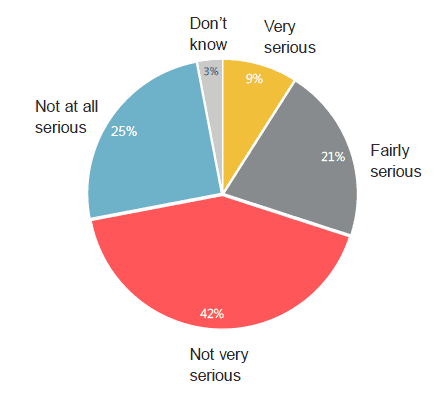
Base: All (1,088)
Almost nine in ten (87%) respondents regarded organised crime as a serious problem in Scotland as a whole, with just 11% saying it was not very or not at all serious ( Figure 2.3). Again, these figures were in line with those recorded in 2013 (84% and 11% respectively), although the proportion in 2017 saying organised crime was very serious, was higher, by six percentage points.
Reflecting the results for neighbourhoods, more women than men regarded organised crime as a serious problem nationally (90% compared to 83%). Further, people living in the most deprived areas were more than twice as likely as those in the least deprived to say organised crime was a very serious problem nationally (56% compared to 27%). Those who had been personally affected by such activity were more likely to cite it as a serious problem than those who had not (60% compared to 34%).
Figure 2.3: Perceived seriousness of organised crime in
Scotland
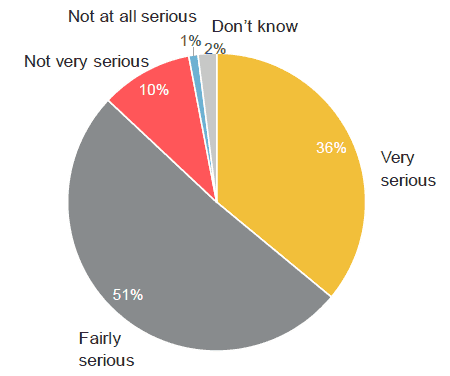
Base: All (1,088)
As Figure 2.4 shows, respondents believed the groups most affected by organised crime in Scotland were the young (42%), the old (30%) and the economically disadvantaged (16%). These results generally held across the different subgroups of respondents, though people in the least deprived areas were twice as likely as those in the most deprived to cite the economically disadvantaged (23% compared with 12%).
Figure 2.4: Groups believed to be the most affected by
organised crime (most common answers given)
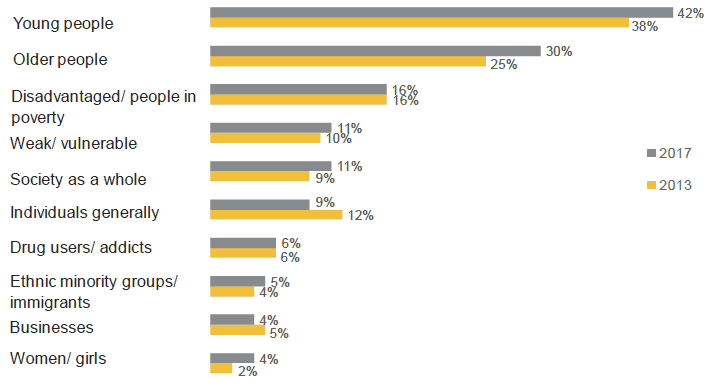
Base: All (1,088 in 2017 and 1,001 in 2013)
The main perceived impacts of organised crime were drug taking or increased drug use (28%) and fear in the community (23%), followed by damage to victims' health (18%), a reduction in the money available for public services (13%), and violence (12%). The figures for drug taking and damage to victims' health were each higher than in 2013, by 11 and seven percentage points respectively. At the same time, the proportion of respondents unable to identify any impacts was down by four percentage points (from 21% to 17%).
Figure 2.5: Perceived main impacts of organised crime in
Scotland (most common answers given)
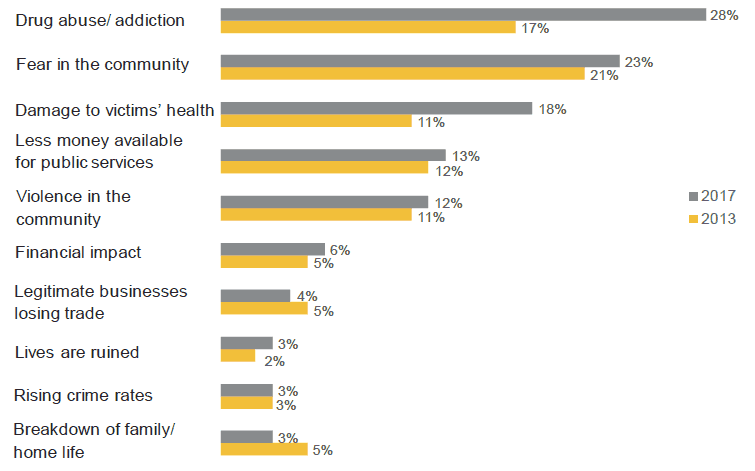
Base: All (1,088 in 2017 and 1,001 in 2013)
While more men than women identified drug taking as an impact of organised crime (33% compared to 24% respectively), there were few other notable sub-group differences in the results.
Responsibility for tackling organised crime
Asked who they thought had a role to play in tackling organised crime in Scotland, respondents most commonly said the Police (87%). That said, around a third (37%) mentioned the Scottish Government and around a quarter (26%) said "everyone". The latter figure was appreciably higher than in 2013 (15%). (Figure 2.6)
Figure 2.6: Perceived responsibility for tackling organised
crime in Scotland (most common answers given)
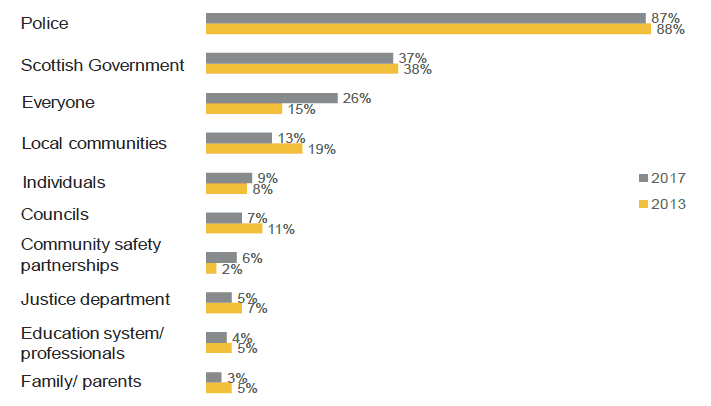
Base: All (1,088 in 2017 and 1,001 in 2013)
Contact
There is a problem
Thanks for your feedback